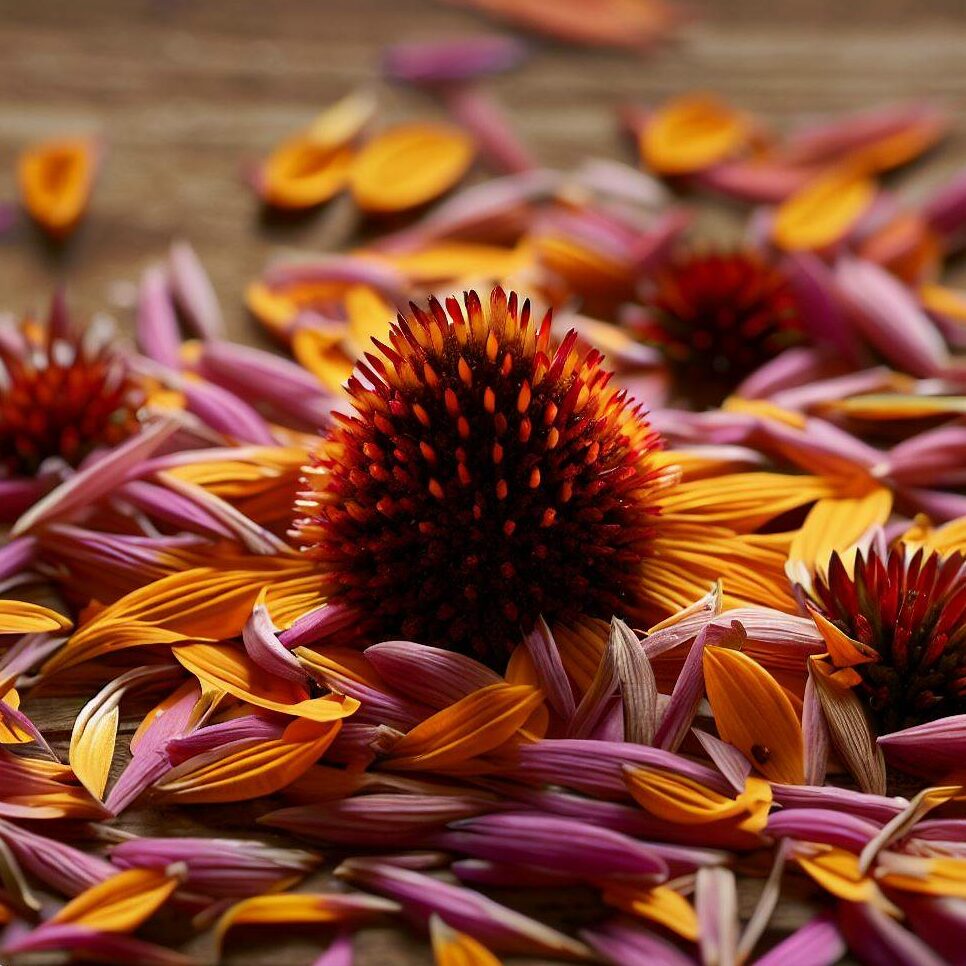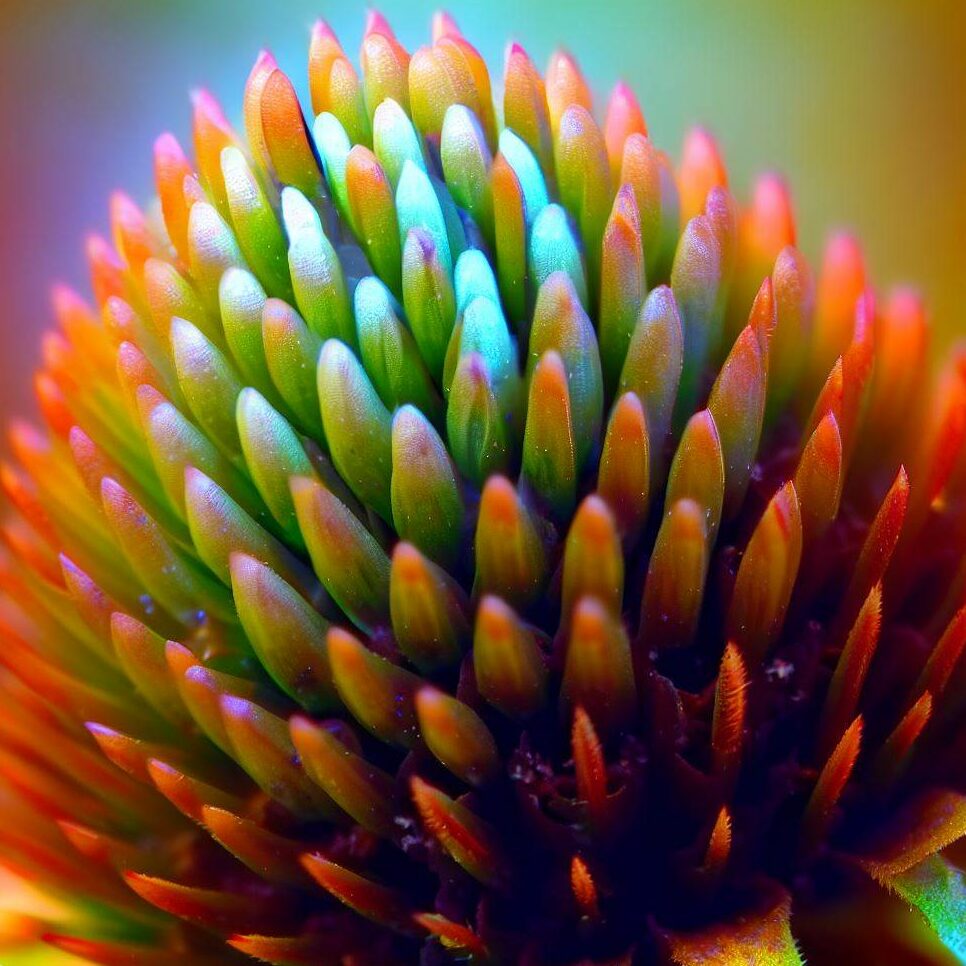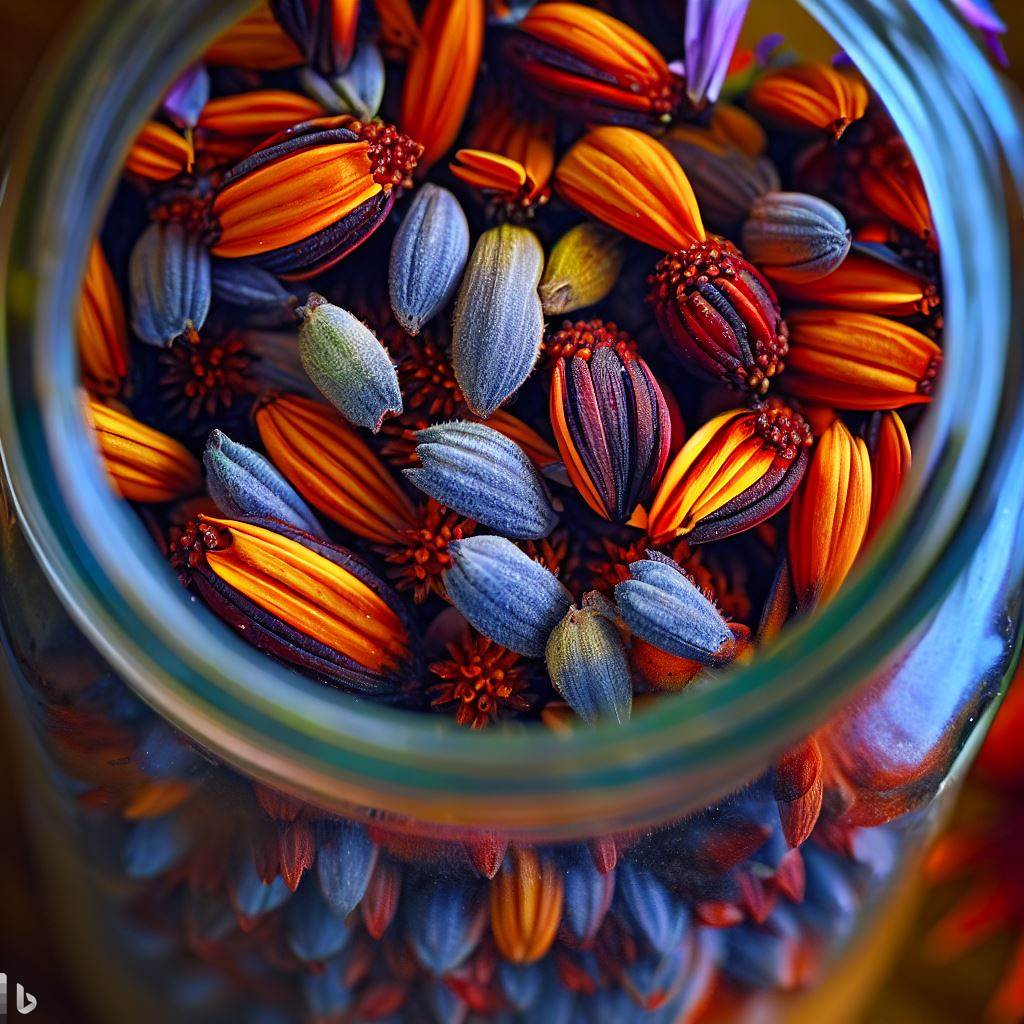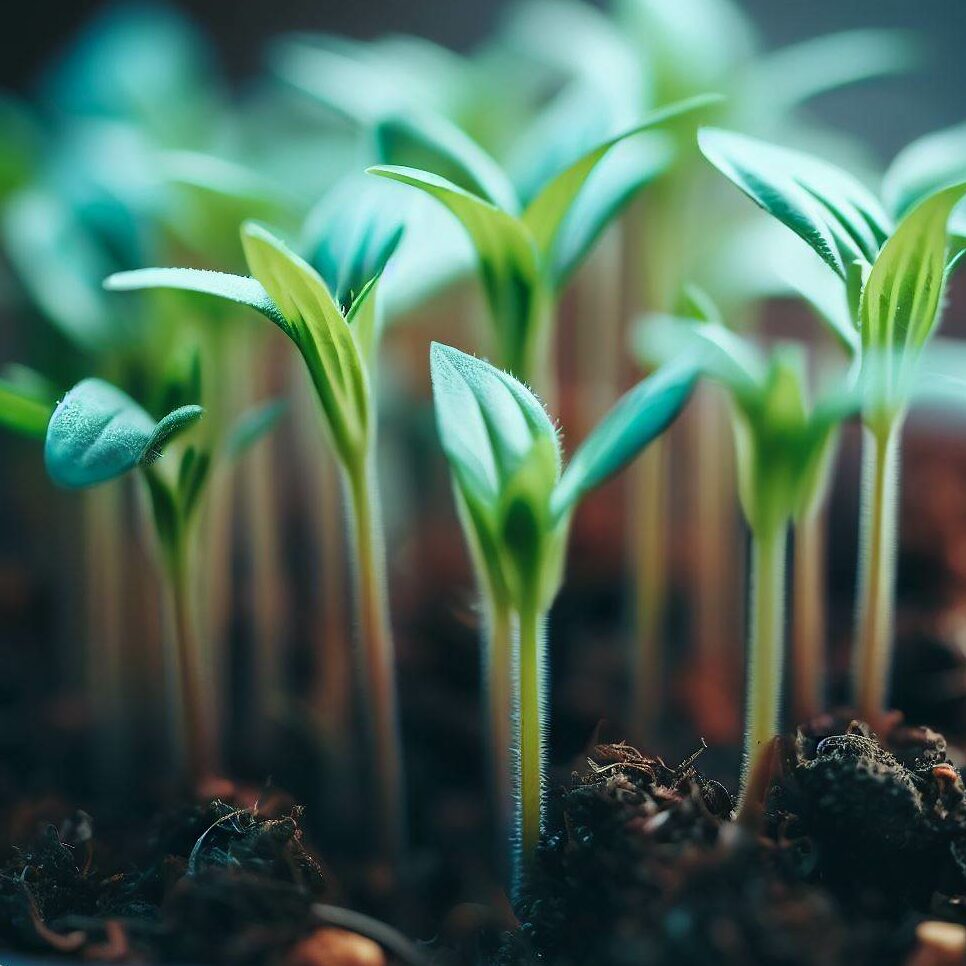This guide is all about harvesting coneflower seeds and the importance of proper storage. Coneflowers, or Echinacea, are not just beautiful additions to your garden, but their seeds can also be a source of new life for the next planting season.
Harvesting coneflower seeds involves a few simple steps. Wait until the coneflower’s seed head turns brown and dries out, which usually happens in late summer or early fall. Cut the seed head off the stem, leaving about 5-6 inches below the seed head. Scrape the seeds out of the cone using your fingers or a small tool. Separate the seeds from the chaff, the darker part of the seed head. Store the dry seeds in a cool, dry place until you’re ready to plant them.

What’s in Store?
In this guide, we’ll walk you through the entire process, from knowing when the seeds are ready for harvest, to the actual harvesting, and finally, how to store them properly for future planting. We’ll also answer some of the most common questions about coneflower seeds.
🌼 Coneflower Clues: Harvesting and storing coneflower seeds not only saves you money but also allows you to share the beauty of coneflowers with your friends and family. Seeds make for thoughtful gifts for fellow garden enthusiasts! 🌼
So, whether you’re a seasoned gardener or a beginner looking to expand your gardening skills, this guide is for you.
Understanding Coneflowers and Their Seeds
Before we delve into the process of harvesting and storing coneflower seeds, it’s important to understand what coneflowers are and the nature of their seeds.
What are Coneflowers?
Coneflowers, scientifically known as Echinacea, are popular perennial plants known for their vibrant petals and distinctive cone-shaped centers. They are native to North America and are a favorite among gardeners for their hardiness and ability to attract pollinators like butterflies and bees.
The Seeds of Coneflowers
The seeds of coneflowers are found within their cone-shaped centers. As the flower matures, the center dries out and turns brown, revealing the seeds. Each coneflower can produce hundreds of seeds, making them an excellent choice for coneflower propagation.
🌼 Coneflower Clues: Coneflower seeds are small, dark, and have a rough texture. They are typically ready for harvest in late summer or early fall when the flower heads have dried out. 🌼
Native Coneflowers vs. Hybrids
While there are many varieties of coneflowers, they can generally be categorized into two types: native coneflowers and hybrids. Native coneflowers are those that naturally occur in the wild, while hybrids are the result of cross-breeding different species or varieties to achieve specific characteristics.
It’s important to note that while hybrid coneflowers can be stunningly beautiful, their seeds may not always be viable. This means that they may not germinate or may not produce plants that look like the parent plant. On the other hand, native coneflowers produce reliable seeds that can be harvested and planted with confidence.
🌼 Coneflower Clues: When planning to harvest seeds, it’s best to choose native coneflowers to ensure you’ll get viable seeds that will grow into new plants. 🌼

When to Harvest Coneflower Seeds
Knowing the right time to harvest coneflower seeds is crucial to ensure their viability for the next planting season. So, when is the ideal time to harvest these seeds?
The Ideal Time for Harvesting
The best time to harvest coneflower seeds is in late summer or early fall. This is typically when the flowers have bloomed, and the seed heads have had enough time to mature and dry out.
🌼 Coneflower Clues: Patience is key when it comes to harvesting coneflower seeds. Harvesting too early can result in immature seeds that may not germinate. 🌼
Signs That the Seed Head is Ready
How do you know if the seed head is ready for harvesting? Look for these signs:
- The petals have fallen off, leaving only the cone-shaped center.
- The center has turned brown and feels dry to the touch.
- You can see the seeds when you look closely at the cone.
When you observe these signs, it’s time to get your gardening tools and start harvesting those coneflower seeds!
How to Harvest Coneflower Seeds
Now that we’ve covered when to harvest coneflower seeds, let’s dive into the how. Harvesting coneflower seeds is a straightforward process that requires just a few simple tools and steps.
Tools You’ll Need
- Pruning shears or scissors
- Paper bags or envelopes
- A clean, flat surface for seed cleaning
🌼 Coneflower Clues: Using sharp tools not only makes the process easier but also helps prevent damage to the plant. 🌼
Step-by-Step Guide to Harvesting Coneflower Seeds
Follow these steps to successfully harvest your coneflower seeds:
- Identify the Ready Seed Heads: Look for seed heads that are brown and dry with visible seeds.
- Cut the Seed Head: Using your pruning shears or scissors, cut the seed head off the plant. You can cut it a few inches below the seed head or at the base of the stem, depending on your preference.
- Place in a Bag: Put the seed head in a paper bag or envelope. This will catch any seeds that fall out during transport.
- Remove the Seeds: Over a clean, flat surface, scrape the seeds out of the cone using your fingers or a small tool. Be gentle to avoid damaging the seeds.
- Separate Seeds from Chaff: The chaff is the darker part of the seed head. Separate the seeds from the chaff as much as possible. Some chaff mixed in with the seeds is okay and won’t affect germination.
🌼 Coneflower Clues: Harvesting coneflower seeds can be a bit messy, so it’s a good idea to do it outdoors or over a large tray or piece of newspaper. 🌼
And there you have it! You’ve successfully harvested your coneflower seeds. But we’re not done yet. The next step is to store these seeds properly to ensure they’re ready for the next planting season. But that’s a topic for another section.
Answering Your Questions
One of the most common questions we get is, “How do you harvest coneflower seeds?” The process, as outlined above, is quite simple and can be done by anyone, even those new to gardening. The key is to wait until the seed heads are fully mature and dry before harvesting. With a little patience and care, you’ll have a bounty of coneflower seeds ready for planting!
Separating Seeds from the Chaff
Once you’ve harvested your coneflower seeds, the next step is to separate them from the chaff. But what exactly is chaff, and how do you separate it from the seeds? Let’s dive in.
Understanding Chaff
Chaff is the dry, scaly protective casings of the seeds of cereal grain, or in this case, the coneflower seeds. It’s lighter than the seeds and often darker in color. While some chaff mixed in with your seeds won’t affect germination, it’s best to remove as much of it as possible to prevent mold and make planting easier.
🌼 Coneflower Clues: In the past, farmers used to separate chaff from grain by tossing it in the air and letting the wind blow the lighter chaff away, a process known as winnowing. 🌼
How to Separate Coneflower Seeds from Chaff
Separating coneflower seeds from chaff is a simple process that requires a bit of patience. Here’s how to do it:
- Spread the Seeds and Chaff: Spread your harvested seeds and chaff out on a flat, clean surface. A large tray or piece of paper works well for this.
- Sort Through the Mixture: Using your fingers, gently sort through the mixture, separating the seeds from the chaff. The seeds are usually larger and heavier than the chaff.
- Use a Sieve: If you have a lot of seeds, you can use a sieve with holes just large enough for the seeds to pass through but too small for the chaff.
🌼 Coneflower Clues: Doing this process outdoors on a breezy day can help, as the wind can blow away the lighter chaff while the heavier seeds remain. 🌼
And that’s it! You’ve successfully separated your coneflower seeds from the chaff. Now, they’re ready for storage or planting.
Answering Your Questions
So, how do you separate coneflower seeds from the chaff? As you can see, it’s a simple process that requires a bit of patience and care. With these steps, you’ll have clean coneflower seeds ready for your garden in no time!
Storing Coneflower Seeds
After the hard work of harvesting and separating your coneflower seeds, it’s crucial to store them properly to ensure they’re ready for planting when the time comes. So, how do you store coneflower seeds for the winter? Let’s find out.

Best Practices for Storing Coneflower Seeds
Proper storage of coneflower seeds can extend their viability and increase the success of your future plantings. Here are some best practices to follow:
- Dry the Seeds: Before storing, ensure the seeds are completely dry. Any moisture can lead to mold and ruin the seeds.
- Use Proper Containers: Store your seeds in airtight containers like glass jars or sealable plastic bags. This protects them from moisture and pests.
- Label Your Seeds: Don’t forget to label your seeds with the type and the date of harvest. This will help you keep track of what’s what, especially if you’re saving seeds from multiple plants.
- Store in a Cool, Dark Place: Seeds store best in cool, dark conditions. A basement, garage, or even the refrigerator can work well.
🌼 Coneflower Clues: If storing seeds in the refrigerator, place them in the back where the temperature is most consistent. 🌼
Answering Your Questions
So, how do you store coneflower seeds for the winter? By ensuring they’re dry, using airtight containers, labeling them, and storing them in a cool, dark place, you can keep your coneflower seeds viable and ready for planting when spring arrives.
Planting and Germinating Coneflower Seeds
Now that you’ve harvested, separated, and stored your coneflower seeds, it’s time to look forward to the next step: planting and germination. This section will guide you on how deep and when to plant coneflower seeds, how to germinate echinacea seeds, and the importance of stratification.
Planting Coneflower Seeds
Planting coneflower seeds is a straightforward process. Here’s a step-by-step guide:
- Choose the Right Time: Coneflower seeds can be planted in late fall or early spring.
- Prepare the Soil: Coneflowers prefer well-draining soil. Add compost or organic matter to improve soil fertility.
- Plant the Seeds: Plant the seeds about 1/4 to 1/2 inch deep in the soil.
- Space the Seeds: Space the seeds about 18 to 24 inches apart to give the plants room to grow.
- Water the Seeds: Water the seeds thoroughly after planting, and keep the soil moist until the seeds germinate.
🌼 Coneflower Clues: Coneflowers are drought-tolerant once established, but they need regular watering during the germination period. 🌼
Germinating Echinacea Seeds
Germinating echinacea seeds requires a process called stratification. Stratification is a method of simulating the natural winter conditions that some seeds need to break dormancy. Here’s how to do it:
- Moisten a Handful of Sand: The sand should be damp but not soaking wet.
- Mix the Seeds with the Sand: This helps to keep the seeds moist and prevents them from clumping together.
- Place the Mixture in a Plastic Bag: Seal the bag and place it in the refrigerator.
- Wait: The seeds need to be in the refrigerator for about 4-6 weeks to break dormancy.
- Plant the Seeds: After stratification, the seeds are ready to be planted in the soil.
🌼 Echinacea Essentials: Don’t forget to label the bag with the date you put it in the refrigerator! 🌼

Answering Your Questions
Do coneflower seeds need to freeze to germinate?
No, they don’t need to freeze, but they do need a period of cold stratification to break dormancy.
Do coneflowers reseed themselves?
Yes, coneflowers can self-seed if the conditions are right.
Should I freeze coneflower seeds before planting?
No, freezing is not necessary, but cold stratification in the refrigerator is recommended.
Do coneflower seeds need to be cold stratified?
Yes, cold stratification helps to break seed dormancy and improve germination rates.
How do you cold stratify Coneflower seeds?
By mixing them with moist sand and storing them in a sealed plastic bag in the refrigerator for 4-6 weeks.
Frequently Asked Questions
Here are some additional questions you might have about coneflower seeds and their answers:
How do you save cornflower seeds?
Saving cornflower seeds is similar to saving coneflower seeds. Wait until the flowers have faded and the seed heads have dried out. Cut off the seed heads and shake them over a container to collect the seeds. Store the seeds in a cool, dry place until you’re ready to plant them.
How do you dry Echinacea seed heads?
To dry Echinacea seed heads, cut them off the plant and place them in a well-ventilated area out of direct sunlight. Leave them to dry for a few weeks. Once they’re dry, you can shake out the seeds and store them.
How do you collect purple coneflower seeds?
Collecting purple coneflower seeds is the same as collecting any other coneflower seeds. Wait until the seed heads have dried on the plant, then cut them off and shake out the seeds.
How do I save Coneflower seeds for next year?
To save coneflower seeds for next year, store them in a cool, dry place after you’ve harvested them. You can store them in a paper envelope or a glass jar. Just make sure to label them with the date and type of seeds.
Conclusion
In this article, we’ve explored the process of harvesting, storing, and planting coneflower seeds. From understanding the unique characteristics of coneflowers and their seeds, to learning when and how to harvest, separate, store, and germinate them, we’ve covered it all.
Harvesting your own coneflower seeds can be a rewarding experience, not to mention a great way to propagate these beautiful plants. So why not give it a try? With the knowledge you’ve gained from this guide, you’re well-equipped to start your own coneflower seed harvesting journey.
